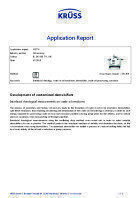Analytical Instrumentation
Transferring interfacial rheology data from lab tests to practical midstream processing: Optimizing demulsifier performance to reduce corrosion and pipeline pressure peaks
Feb 08 2016
Author: Dr Robert Minch on behalf of Kruss GmbH
During the process of oil recovery, water-in-oil (w/o)-emulsions are formed due to the presence of surface active substances, being natural components of the oil or being part of flooding mixtures, e. g. in enhanced oil recovery (EOR). The formation of such emulsions alters the oil's viscosity, creating pressure peaks in midstream processing that eventually damage technical equipment like pumps. Additionally, w/o-emulsions contain an elevated amount of salty water, which promotes material corrosion in petroleum refining. To avoid these technical problems, so-called demulsifiers are in use that break up w/o-emulsions and result in a decreased viscosity and water content of crude oil. As parameters like water and oil composition differ in between reservoirs, demulsifiers have to be selected carefully and on an individual level.
Different demulsifier systems were investigated on a lab scale by means of interfacial rheology measurements, using the oscillating drop method. Different concentrations of mixtures of asphaltenes in toluene were characterized. It was found that the change in storage modulus (E') of the asphaltene-water interface upon addition of demulsifying agents strictly correlated with the stability of w/o emulsions. Based on these lab results, the most promising demulsifier system was identified. The real perfomance of this system was then tested in field for practical midstream processing and results were compared to a commercially available standard demulsifier. It was shown that deviations in pumping pressure could be reduced from 11.5 ± 2 atm to 11.0 ± 0.5 atm after switching from the standard demulsifier to the system that was designed according to interfacial rheology lab tests. In addition, the water as well as the salt content could be reduced significantly for three different crude oil samples. These results clearly show how interfacial rheology measurements on a lab scale can be transferred to petroleum midstream processing to optimize the performance of demulsifying agents and eventually prevent pressure peaks and corrosion.
Digital Edition
PIN 25.3 June/July
June 2024
Analytical Instrumentation - Recent Advances In Various Bench Scale Accelerated Oxidative Testing Methods For Fuels - Petrochemical Industry: Anton Paar Solutions Streamline Processes, Reduce H...
View all digital editions
Events
Jul 30 2024 Jakarta, Indonesia
Jul 30 2024 Jakarta, Indonesia
China Energy Summit & Exhibition
Jul 31 2024 Beijing, China
Jul 31 2024 Chengdu, China
Aug 05 2024 Moon Township, PA, USA















